This post contains affiliate links.
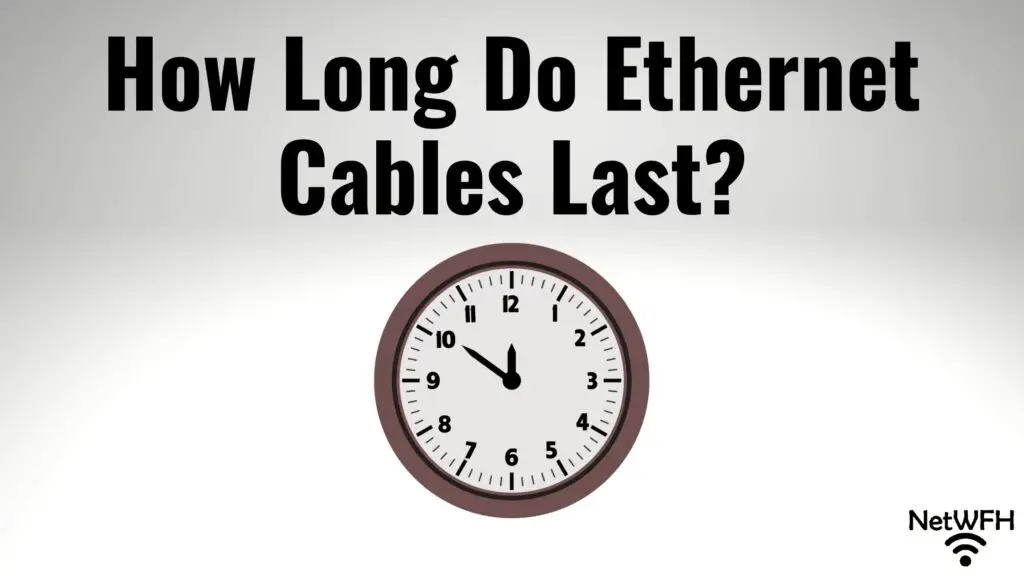
Nothing lasts forever.
It’s a saying as old as time. It’s also true.
Especially for the devices in your home network.
For one reason or another, all the components in your home network will need to be replaced at some point. This includes your:
- Modem
- Router
- Computers/laptops
- Smartphones
- Gaming systems
- Ethernet switches
- Ethernet cables
Those are just a few examples. The actual list is much longer than this, and it’s growing by the day as more devices are connected to the internet.
They’ll all need to be replaced eventually.
The real question is: how long will each of these components last before they need to be replaced?
In this post, the focus is on ethernet cables.
So how long can you expect ethernet cables to last?
Your ethernet cables can last you 20 years (or longer) if the following conditions are met:
- The cables are used in a dry and mild environment
- You do not abuse your cables and you handle them with care
- You buy cables that allow for future growth of your network and can support demand for faster speeds
In the following sections, I’ll detail everything you need to do to get the maximum life out of your cables.
What is an ethernet cable made of?
To understand how to preserve your ethernet cables, you should have a good idea of what they’re made of.
Before you get overwhelmed, I have some good news: ethernet cables are pretty simple devices.
Most standard ethernet cables consist of 8 copper wires inside of a PVC (polyvinyl chloride) sheath.
The PVC sheath is meant to protect the copper wires in the cable from being damaged. It also serves as a barrier against moisture and other elements in the environment that can cause the wires to oxidize or corrode.
Inside the cable, the 8 copper wires are usually separated into 4 pairs of 2 wires each. These 4 pairs of wire are twisted together inside the cable.
Here’s what the twisted pairs look like:
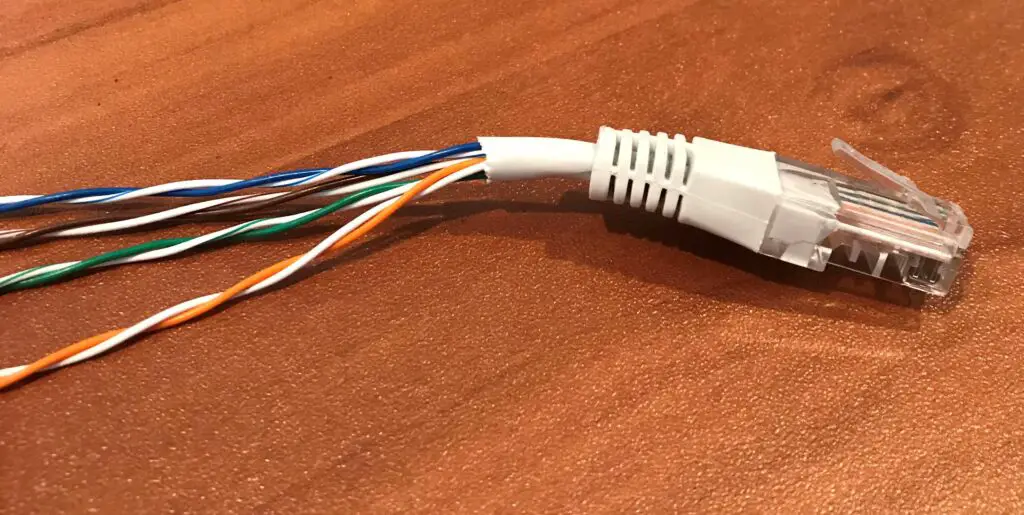
This type of cable is called an unshielded cable.
You’ll also find that some cables will have extra foil shielding around the 8 wires in the cable. These are called shielded cables.
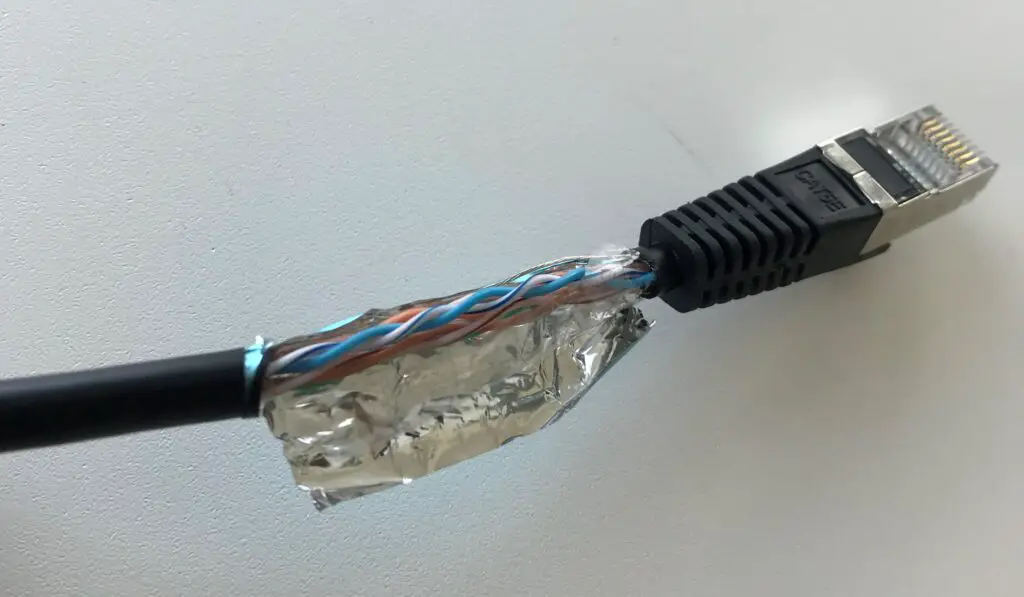
The shielding protects the cable from electromagnetic interference (EMI) in environments where there’s a lot of commercial equipment nearby.
Shielded and unshielded cables are the two types of ethernet cable configurations. Even though shielded cables have more components than unshielded cables, neither of them are complex.
Due to the fact that ethernet cables are simple components, it’s easy to make them last a long time.
How long can an ethernet cable last?
Although ethernet cables are simple components, that doesn’t mean they can’t last a long time. On the contrary, they’re easy to preserve and take care of.
Before we get into the specific steps for what you can do to make your cables last a long time, let’s establish some expectations.
If you do all the right things, it shouldn’t be surprising for your cables to last 20 years or longer.
In fact, I’ve read that some poeple have cables that are 30 years old and still working perfectly. Considering ethernet cables are inexpensive components to begin with, that’s some pretty good bang for your buck.
The best part is, there’s no reason why your cables can’t last just as long.
At this point, I’m sure you’re wondering what you have to do to make your cables last 20 years. Let’s take a closer look.
How to make ethernet cables last a long time
If you want your ethernet cables to last a long time, you’re in luck.
It doesn’t take much to set your cables up for success.
If you want your cables to last a long time, there are a few things you need to do:
- Handle your cables with care
- Keep your cables out of harsh environments
- Buy cables specific to the environment they will be used in
- Use cables that can support your future network needs
- Buy cables from a quality manufacturer
Let’s break down each of the actions above to make sure you can put a proper plan in place for your cables.
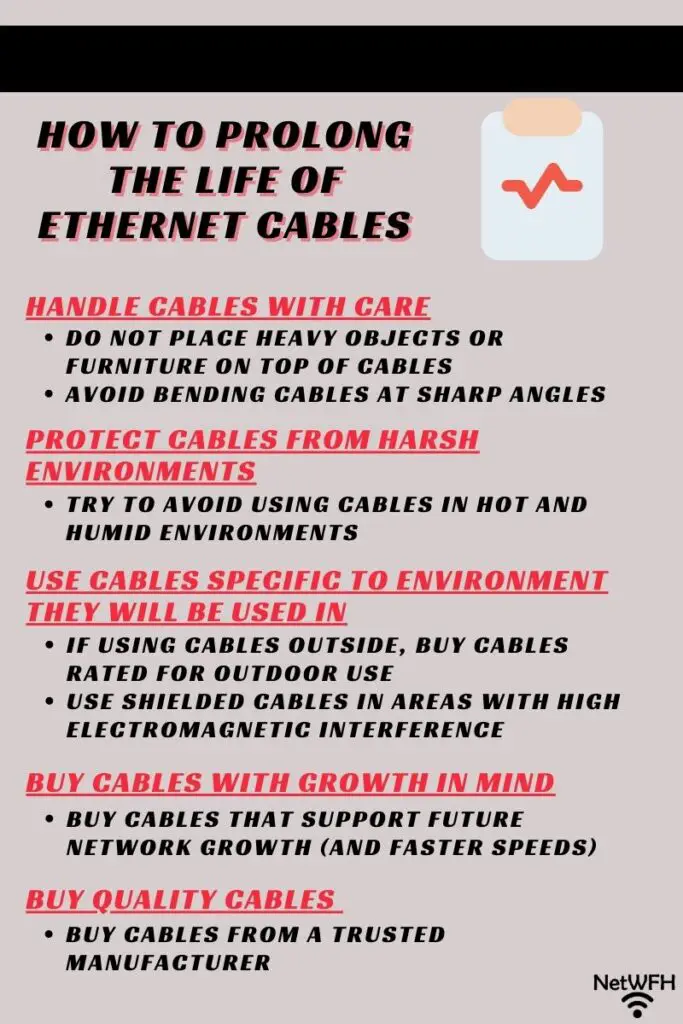
Handle your cables with care
This one should be pretty straightforward.
I’ll accompany this item with a life lesson: if you want things in your life to last, you need to handle them with care.
This goes for your relationships, your house, your car, and most of all, your ethernet cables.
As I mentioned previously, most of the ethernet cables you’ll be dealing with in your home or office have a PVC sheath.
Although PVC will provide your cables with some protection, it’s not exactly a suit of armor. After all, that’s not the only purpose of the sheath. It’s also meant to be flexible so you can snake your cables into tight spaces.
For an example of the flexibility that PVC provides, here’s how much you can safely bend a cat5e cable without it causing any problems:
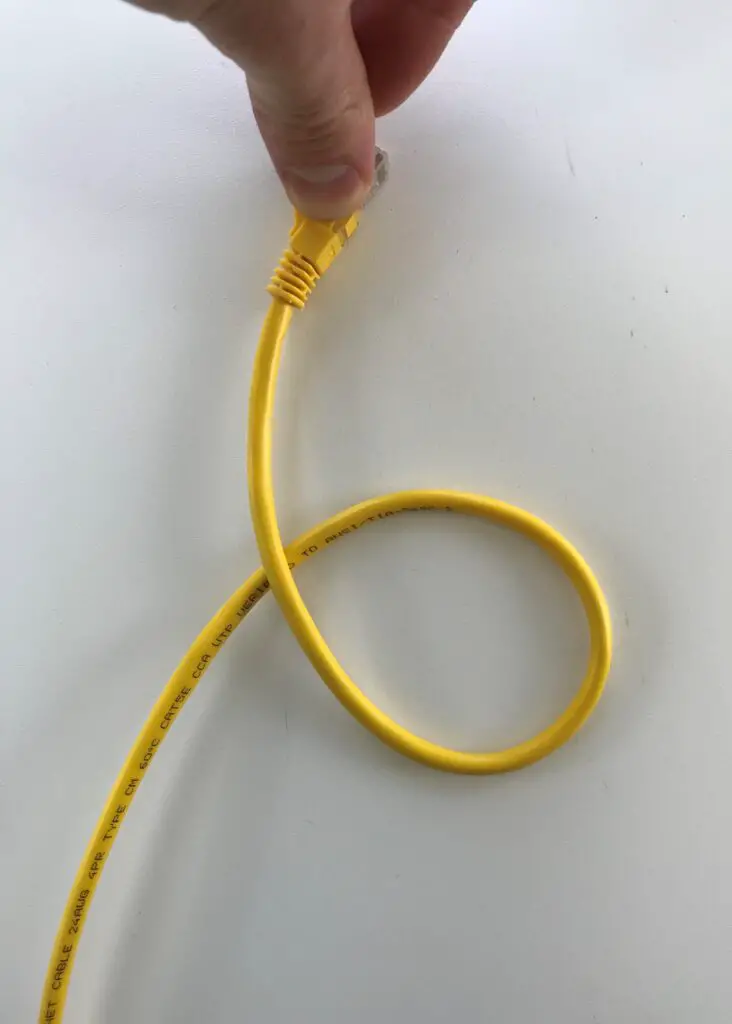
With that said, even with the added flexibility that PVC provides, it should also provide your cables with plenty of protection.
The key here is to protect the 8 copper wires inside the ethernet cable. If these wires get damaged, your cable will stop working properly.
To ensure your ethernet cable doesn’t get damaged, you should be careful with how your cables are handled when they’re set up.
This includes:
- Making sure your cables aren’t bent at extreme angles
- Preventing the cables from being yanked or pulled when disconnecting them
- Avoiding laying anything heavy on the cable that may crush it
- Gently coiling any excess cable and using a cable tie to secure it
I’m not saying you need to handle your ethernet cables like they’re made of glass here.
They’re still fairly durable items. Just be mindful of how you’re handling them.
It’ll pay off in the long run.
Protect your cables from harsh environments
Once you buy your ethernet cables and you have them connected to your devices, there are two variables that can limit how long they last.
The first variable is how you treat them, which I detailed in the previous section.
The second variable is the environment they’re in and where they’re used.
Ethernet cables are electronic devices. They transfer data from one system to another using pulses of electricity. When one device wants to communicate with another, it sends electric pulses through the copper wires in the cable to the other device.
Now that we’ve established that ethernet cables rely on electricity, let’s ask ourselves the question: what do electronic devices dislike?
The answer here is sunlight, heat, and humidity.
Regardless of the electronic device, almost all of them are negatively impacted by sunlight, heat, and humidity.
This is especially the case if the device isn’t made to interact with a hot and humid environment. You can put ethernet cables in that category.
Standard ethernet cables are designed for use in home and office environments. These areas are often dry and climate controlled.
If cables are exposed to hot environments where there’s a lot of moisture in the air, it can corrode the wires inside them.
The same goes for sunlight exposure. If a standard ethernet cable is exposed to a lot of sunlight, it’ll wear down the sheath protecting the wires in the cable.
Both these situations are not good. If the wires inside an ethernet cable corrode or the sheath degrades, it’ll greatly shorten the cable’s lifespan.
So keep this in mind when you’re deciding where you’ll use your ethernet cables. If you need an ethernet cable that’ll be exposed to a harsh environment, you’ll need a special cable.
Speaking of which…
Buy cables for the environment they will be used in
This goes hand in hand with the previous section.
Your everyday ethernet cables are made for pretty comfortable environments. That doesn’t mean you’re out of luck if you need to use a cable in a harsh environment, however.
There are a variety of specialty ethernet cables you can buy depending upon where you’ll use them.
The key here is identifying the environment where the cable will be used.
Let’s take an example.
I mentioned earlier that some ethernet cables have extra foil shielding to protect them from electromagnetic interference.
These shielded cables are meant for environments with lots of commercial equipment in the area. With an unshielded cable, the electric signals given off by the nearby equipment can prevent the cable from working properly.
The message here is if you need cables where there are commercial air conditioners or heavy machinery nearby, grab some shielded ethernet cables.
The same goes for other challenging environments.
If you need to run an ethernet cable outside, you’re in luck as well. They make cables that’re reinforced to better withstand the elements. These outdoor rated ethernet cables are better protected from moisture and ultraviolet rays that would damage a standard ethernet cable.
The key takeaway here is that you need to get cables that’re designed for the environment you’ll use them in. If you don’t, you’ll have to replace them much sooner than you’d like.
Get cables based upon your future network needs
Ok, we’ve gone over the two variables that can extend the life of your cables once you own them.
But wait, there’s more.
There are actually a few things you can do to extend the life of your cables before you even buy them.
The first one comes down to planning.
Have you heard of the term future proofing?
To put it simply, future proofing is the process of accounting for your future needs in the original design of something.
So how does this apply to ethernet cables?
Depending upon the category of a given ethernet cable, it’ll have a maximum speed that it can support. When buying your ethernet cables, you should make sure that you buy cables that allow for growth of your network.
What I mean here is you should do a little forecasting.
Do you think you’ll be upgrading your internet plan in the future? Are your internet needs going to change at all in the coming years?
Some situations that might cause your internet needs to change in the future are:
- Adding more internet-connected devices to your network
- Upgrading to a faster internet plan
- Adding more internet users to your household
- Working from home as opposed to going to the office
When picking out which ethernet cables to buy, you should take the above situations into consideration.
For me personally, I like to include a significant buffer for growth when planning my network. Internet plans are only going to get faster (and more affordable) in the future.
Here’s a pro tip: if you’re in the market for ethernet cables, you should buy cat6 cables.
Cat6 cables support a maximum speed of 10 Gbps for cables shorter than 180 feet. That should give your network plenty of room to grow regardless of your current network demands.
Buy cables from a quality manufacturer
Let’s talk about the other step you can take to prolong the life of your cables before you buy them.
This is all about setting yourself up for success.
You need to make sure you’re buying quality cables.
In today’s world, this may be easier said than done.
When it comes to ethernet cables, there are tons of different options to choose from on Amazon or at your local computer store.
What makes things even more challenging is the fact that all ethernet cables look the same from the outside. You can’t tell if a cable has been cheaply made or not.
Why does this matter?
Common sense will tell you that quality cables will last longer than ones that are cheaply made. Ethernet cables aren’t expensive to begin with, so if you have to spend an extra dollar for a quality cable that’ll last you 10 years longer, it’s well worth it.
The best way to get quality cables is to go with vendors that you know and trust.
If you have ethernet cables in your home that’ve lasted you a long time, buy more from the same vendor.
Not sure which vendors are good?
Buy cables from a company you’ve heard of before. You can also poll the audience and ask others about their experiences with different cables.
For me personally, I’ve had good experiences with ethernet cables made by Monoprice.
That’s just my experience though.
Feel free to do your own research, or buy cables from a few different vendors to see which ones work best.
The key takeaway here is that a few minutes of research can save you a lot of headache. The less time (and money) you have to spend replacing your cables, the better.
Do ethernet cables degrade over time?
The actions listed above will help ensure that your ethernet cables last as long as possible.
A common follow up question I’ve seen about how long ethernet cables last is if they’ll wear out or degrade over time. In other words, even if you follow everything I detailed above, will your cables eventually wear out?
The simple answer here is no.
If you have an ethernet cable that supports the required speed of your network and it’s in a protected environment, it could theoretically last you forever.
If we think about what’s happening inside your ethernet cables, this might make more sense.
All that’s really happening is electricity is moving through copper wires. The wires won’t wear down if electricity is passed through them for a long time.
Imagine a situation where a copper cable is in a science lab where it’s in ideal conditions with a controlled climate and no humidity. You’d be able to pass electricity through it forever.
The same is true for your ethernet cables.
They could technically last forever. The truth is, however, that they won’t.
You’ll have to replace them because your network will outgrow them and you’ll need to support faster speeds. Another possibility is that the protective sheath around the copper wires in your cables will wear down depending upon the environment they’re in.
At some point, you’ll eventually have to replace your ethernet cables. It just won’t be because your cables have expired or worn out.
Wrap up
To make your ethernet cables last as long as possible, it takes a little bit of planning and effort. With that said, if you take the necessary steps and keep them in the right environment, you won’t have to worry about replacing your cables for a long time.
If you have any questions about the material above, or you’d like to share your experience with your ethernet cables lasting a long time, please leave a comment below.
If for some reason you liked this article or the way I explain topics about your home network, check out the following posts on related topics:
The Difference Between Cat5e and Cat6 Cables
What Does Cat Mean for Ethernet Cables?
Shielded vs Unshielded Cables: A Full Comparison
